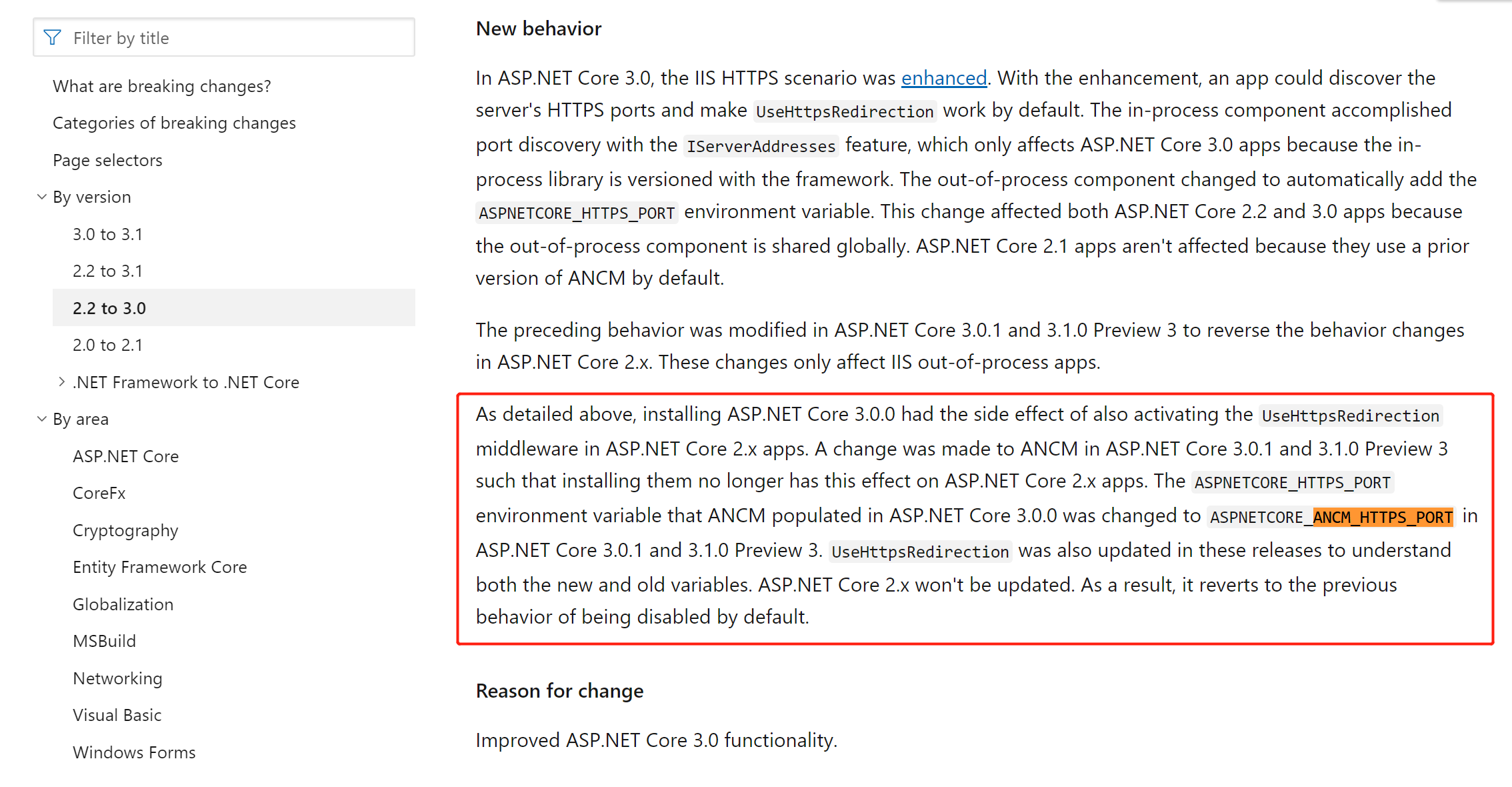概述
上文提到3.1版本默认没有使用Hsts,但是使用了这个中间件。看名字就很好理解,https跳转,顾名思义,就是跳转到
https地址。
使用场景,当用户使用http访问网站时,自动跳转到https地址。这样更加安全,不需要用户特意输入https://协议。
具体做了些我们一起来看看。
app.UseHttpsRedirection();
使用方法
跟Hsts一样,HttpsRedirection默认是不需要注入的,除非你需要修改默认配置。
services.AddHttpsRedirection(config =>
{
//https地址的端口号,默认null
config.HttpsPort = 12345;
//跳转响应的状态码,默认307
config.RedirectStatusCode = 302;
});
直接使用中间件即可
app.UseHttpsRedirection();
源码解析
源代码很简单,只有两个类:HttpsRedirectionOptions配置类,HttpsRedirectionMiddleware中间件
HttpsRedirectionOptions就只有两个配置项
/// <summary>
/// Options for the HttpsRedirection middleware
/// </summary>
public class HttpsRedirectionOptions
{
/// <summary>
/// The status code used for the redirect response. The default is 307.
/// </summary>
public int RedirectStatusCode { get; set; } = StatusCodes.Status307TemporaryRedirect;
/// <summary>
/// The HTTPS port to be added to the redirected URL.
/// </summary>
/// <remarks>
/// If the HttpsPort is not set, we will try to get the HttpsPort from the following:
/// 1. HTTPS_PORT environment variable
/// 2. IServerAddressesFeature
/// If that fails then the middleware will log a warning and turn off.
/// </remarks>
public int? HttpsPort { get; set; }
}
重点看下中间件做了些什么。代码量很少,大体是这些逻辑。
- 如果请求是Https,跳过本中间件
- 中间件会依次尝试从这三个地方取端口号:HttpsRedirectionOptions的配置,HttpsRedirectionOptions,HTTPS_PORT环境变量或配置,IServerAddressesFeature(如果Webhost上绑定了https地址,本中间件能够解析出来端口号)。
- 如果没有解析出来https的端口号,则跳过本中间件。
- 如果能够解析出来https端口号,则拼接出来https地址,返回307跳转响应报文(或者配置的其他状态码)。
注:3.1同时支持HTTPS_PORT和ANCM_HTTPS_PORT这两个环境变量。

https://docs.microsoft.com/en-us/dotnet/core/compatibility/2.2-3.0
public class HttpsRedirectionMiddleware
{
private const int PortNotFound = -1;
private readonly RequestDelegate _next;
private readonly Lazy<int> _httpsPort;
private readonly int _statusCode;
private readonly IServerAddressesFeature _serverAddressesFeature;
private readonly IConfiguration _config;
private readonly ILogger _logger;
/// <summary>
/// Initializes the HttpsRedirectionMiddleware
/// </summary>
/// <param name="next"></param>
/// <param name="options"></param>
/// <param name="config"></param>
/// <param name="loggerFactory"></param>
public HttpsRedirectionMiddleware(RequestDelegate next, IOptions<HttpsRedirectionOptions> options, IConfiguration config, ILoggerFactory loggerFactory)
{
_next = next ?? throw new ArgumentNullException(nameof(next));
_config = config ?? throw new ArgumentNullException(nameof(config));
if (options == null)
{
throw new ArgumentNullException(nameof(options));
}
var httpsRedirectionOptions = options.Value;
if (httpsRedirectionOptions.HttpsPort.HasValue)
{
_httpsPort = new Lazy<int>(() => httpsRedirectionOptions.HttpsPort.Value);
}
else
{
_httpsPort = new Lazy<int>(TryGetHttpsPort);
}
_statusCode = httpsRedirectionOptions.RedirectStatusCode;
_logger = loggerFactory.CreateLogger<HttpsRedirectionMiddleware>();
}
/// <summary>
/// Initializes the HttpsRedirectionMiddleware
/// </summary>
/// <param name="next"></param>
/// <param name="options"></param>
/// <param name="config"></param>
/// <param name="loggerFactory"></param>
/// <param name="serverAddressesFeature">The</param>
public HttpsRedirectionMiddleware(RequestDelegate next, IOptions<HttpsRedirectionOptions> options, IConfiguration config, ILoggerFactory loggerFactory,
IServerAddressesFeature serverAddressesFeature)
: this(next, options, config, loggerFactory)
{
_serverAddressesFeature = serverAddressesFeature ?? throw new ArgumentNullException(nameof(serverAddressesFeature));
}
/// <summary>
/// Invokes the HttpsRedirectionMiddleware
/// </summary>
/// <param name="context"></param>
/// <returns></returns>
public Task Invoke(HttpContext context)
{
if (context.Request.IsHttps)
{
return _next(context);
}
var port = _httpsPort.Value;
if (port == PortNotFound)
{
return _next(context);
}
var host = context.Request.Host;
if (port != 443)
{
host = new HostString(host.Host, port);
}
else
{
host = new HostString(host.Host);
}
var request = context.Request;
var redirectUrl = UriHelper.BuildAbsolute(
"https",
host,
request.PathBase,
request.Path,
request.QueryString);
context.Response.StatusCode = _statusCode;
context.Response.Headers[HeaderNames.Location] = redirectUrl;
_logger.RedirectingToHttps(redirectUrl);
return Task.CompletedTask;
}
// Returns PortNotFound (-1) if we were unable to determine the port.
private int TryGetHttpsPort()
{
// The IServerAddressesFeature will not be ready until the middleware is Invoked,
// Order for finding the HTTPS port:
// 1. Set in the HttpsRedirectionOptions
// 2. HTTPS_PORT environment variable
// 3. IServerAddressesFeature
// 4. Fail if not sets
var nullablePort = _config.GetValue<int?>("HTTPS_PORT") ?? _config.GetValue<int?>("ANCM_HTTPS_PORT");
if (nullablePort.HasValue)
{
var port = nullablePort.Value;
_logger.PortLoadedFromConfig(port);
return port;
}
if (_serverAddressesFeature == null)
{
_logger.FailedToDeterminePort();
return PortNotFound;
}
foreach (var address in _serverAddressesFeature.Addresses)
{
var bindingAddress = BindingAddress.Parse(address);
if (bindingAddress.Scheme.Equals("https", StringComparison.OrdinalIgnoreCase))
{
// If we find multiple different https ports specified, throw
if (nullablePort.HasValue && nullablePort != bindingAddress.Port)
{
_logger.FailedMultiplePorts();
return PortNotFound;
}
else
{
nullablePort = bindingAddress.Port;
}
}
}
if (nullablePort.HasValue)
{
var port = nullablePort.Value;
_logger.PortFromServer(port);
return port;
}
_logger.FailedToDeterminePort();
return PortNotFound;
}
}
OK,完成了。